THURSDAY'S SCRIPT TIP:
CAST OF THOUSANDS?

Most of the time a screenplay and a movie will be about a Person With A Problem - a Protagonist and an Antagonist (or force of antagonism) and the handful of people who are part of that circle. In Stephen King’s MISERY we have our protagonist writer Paul Sheldon and our antagonist his number one fan Annie Wilkes. There are supporting characters like his editor, the local sheriff, and a couple of other characters. In PET SEMETERY we have the Creed family: Husband, Wife, Son and Daughter. Plus their weird old neighbor Jud, a student named Victor, our protagonist’s father in law, and the family cat. Even CARRIE is mostly Carrie and her Mother and Sue Snell a small group of students who bully Carrie and a couple of Teachers who try to help her... but there are also all of those other students on the periphery of the story. Some of those are just “extras” - characters in your film that fill out the other seats in the class room... but others are active in the story. What do you do if you have a story with a large cast? One Hundred Characters?
In my recent article for Script Magazine, A HUNDRED HENCHMEN, I look at the film KILL! which has 40 Thieves violently robbing the passengers on a speeding train... and a couple of soldiers who try to stop them... and how to turn those 40 Thieves into individual characters through things like weapons and fighting styes plus clothing and attitude and other elements that can take 40 burley guys from Central Casting who play usually henchmen and turn them into *individuals*. But what if we don’t have characters with different weapons and fighting styles... and they are all 18 year old men? And there are literally one hundred of them? How do we make turn those other students in that locker room scene from CARRIE into distinctive individuals?
A HUNDRED INDIVIDUALS
THE LONG WALK (2025)
Screenplay by J.T. Mollner based on a novel by Stephen King.
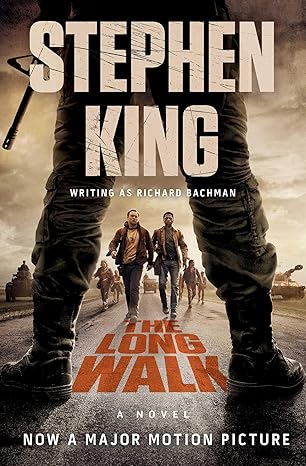
I think this was King's first novel, a Viet Nam War allegory, where in the near future a hundred young men, between 16-18 years old, are selected to represent their state/area on an epic, televised, endurance walk. The winner gets extra goods and supplies for his state... plus a huge cash prize and a wish. You can't stop walking for any reason. You must maintain 3mph. No sleep breaks or bathroom breaks or food breaks - everything must be done walking. If you stop for any reason, you have the count of 3 to get moving again. Or you will be shot dead. There is no finish line, you walk until the other 99 contestants are dead.
So we have a hundred 16-18 year old males... Plus a few other characters. How do we make each different?
Though I have written action flicks and thrillers and horror films, my home genre is mysteries - and those three genres are part of that genre. At least in bookstores. Before Steven King, Horror was a small section of the Mystery aisle in a book store. King’s popularity created an explosion in Horror fiction and now it has its own aisle filled with all kinds of books - often categorized by subgenre. All of the different kinds of Horror. Then there are even subgenres within the subgenres.
But Mysteries often have 10 or 12 people on an island who have a lot in common and one is secretly killing the others one by one. So we have a dozen suspects and they all have something in common that put them on this island. So 12 *similar* people...
And the writer's job is to make each different characters with different personalities and different motives and different goals and different everything else - distinctive and interesting characters who are have something in common. I had fun doing this in my “Fine Upstanding Citizen” novella with a dozen organized crime “department heads” - and one has been ratting them out to the FBI. Finding a way to make a dozen mobsters individuals was fun!
Stephen King had 100 young men all doing the same Walk Or Die competition to benefit their state/area, the film trims it down to 50 - one from each state. That’s still a lot of characters... now add The Major (who oversees the competition) and all of the soldiers who will shoot you dead, a few family members of the contestants plus a handful of spectators who become part of the story. Now, maybe 10 to 15 of those characters are main characters (and survive most of the story) but the rest are still part of the story... And we need to know who they are... Before they get shot dead for slowing down or stopping. If their deaths are supposed to mean something to us, the reader and the viewer, we need to know them as individuals. They might be less fleshed out than those 10 to 15 main characters, but they need to be flesh and blood. So that when we see that blood? We will care.
The physical goal for all of those characters is to be the last one standing (survive) and win the extra rations (etc) for their community.
But each one has a different additional goal, and a different motivation, and a different survival plan, and a different personality and outlook on life, and a different twitch/talisman (physical object that has a special meaning to them that you can tell the audience about or not - up to you), a different method of problem solving that tells us something about their past, one different physical way to tell them apart visually, a different article of clothing that is an extension of their personality, a different vocabulary and thought process, a different way to get what they want and a different way to deal with failure, and part of that earlier vocabulary - each has a different way to say Yes, No, Hello, Goodbye, and any other common words that everyone will say at some point in the story. You need to match a character’s common words and vocabulary to their character, so that something as simple as saying "If you say so" instead of "yes" tells us something about them.
OUR CHARACTERS

In this story, everyone also has a different plan to be the last man standing - which is an important part of the story. Also each has a different level of preparedness which tells us something about the characters. Have they trained? Did they prepare for leg cramps and exhaustion? Because this is a little like the TV show SURVIVOR (or vice versa) they each are allowed some personal items (where those talismans come into play) but also some food. The Game provides them with bottles of bad tasting nutrients to keep them alive... But some have foods and special treats - and those things come with a story that tells us something about the character... Their favorite food or snack that their mother made for them. Why they like it. What it reminds them of. If I were to ask you what the best meal you have ever had in your life was, chances are that the food isn’t as important as the event where you ate it. Our memories are often triggered by senses like taste - so there’s a story behind that food or snack they brought with them. Everything is telling us something about the character.
Our protagonist, Ray Garraty, is from the state where the walk takes place, so he knows the territory. He has prepared for the walk - and been planning to be part of the walk for years... because of his additional goal and motivation. The Major, who oversees the competition, murdered Ray’s father - and Ray wants to win so that he can kill the Major.
Pete McVries is our sidekick to Ray - they are the two main characters in this story, and they have several deep philosophical conversations along the way. His additional goal? He’s been burned by life and is secretly suicidal, plans on just sitting down and being shot dead by the soldiers.
Hank Olson is a motor mouth jokester, the comic relief character. If he wins he’s going to ask for ten naked girls instead of the prize money... but that’s a joke, because we find out that he’s married.
Art Baker is the dreamer of the film’s Four Musketeers (Ray, Pete, Hank, and Art) who wants to go to the Moon if he wins. He’s a religious kid. What the others don’t know is that he’s a dying man, and this is his chance to die a hero... even if he loses and is shot dead.
Rich Harkness aspires to be a writer, and his additional goal is writing his diary of the walk which will be published and make him millions after he wins the competition. He’s a thin kid, and doesn’t seem to have prepared for the walk.
Stebbens is the character that all of the others think will win. He’s in great shape, has planned ahead to the point of having a second pair of shoes if the first set wears out. He has *studied* the walk and the winners. His additional goal is to have tea with his father... The Major who will order him shot dead.
Gary Barkovich is an angry young man who thinks that making everyone else’s life on earth hell will somehow make his life better. He has plans that don’t make much sense - like using the 3 warnings before they shoot you as a rest period... and starting to walk again before times up and they shoot. His “personal item” is a switch blade.
Those are the characters who are the main focus of the story, along with The Major (the Antagonist) but each of the other characters has a moment in the story. They all have distinctive characters, even if we don’t remember their names.
CREATING LOTS OF CHARACTERS

I have a method of breaking my stories (figuring everything out) that I call the Thematic - I figure out my theme based on the story idea and what it means to me... And that gives me a "lens" to see the story through. Which helps me select character types and everything else that can illustrate different aspects of that theme. Different ways to tackle the problem. I'm usually secretly making a point through the story itself, and giving each character a different way of looking at that point (or ignoring it in different ways) so that I can come up with characters whose *existence* is helping me explore the theme.
Stephen King’s novel was an allegory about the Viet Nam War, and the futility of sending boys to a foreign land where many returned in body bags. So the idea of the reward from the Long Walk Competition being survival and prestige for your family and rewards for your homeland mirrors those boys going off to war... and the various reasons those young soldiers had for enlisting... or coping mechanisms for being drafted. Finding that “lens” of theme to see your story through can help you create characters that illustrate different aspects of the story and scenes and everything else.
That might or might not help you figure out your characters, but it's a tool that I use... and it also adds Unity (that Aristotle thing) to the story so that it isn't just a grab bag of unrelated characters on this journey. Each has a different way to tackle the problem, and that's exploring the theme through actions.
So whatever your story is - begin by coming up with a bunch of different secondary goals for your characters. If you have a bunch of high school students or astronauts or wait staff at a restaurant or prisoners doing time or people trapped in a grocery store or whatever - what is their goal in addition to graduating or walking on the moon or finishing this shift with great tips? If you just brainstorm a bunch of different reasons without thinking about the rest of the character stuff? You will get a more interesting list. You aren’t self censoring. I like coming up with a bunch of things and then pick the most interesting ones... the ones that I might not have thought of if I was only thinking about the specifics of the story.
Then the other elements from above - from wardrobe to how they say Yes and No and all of the other common words and phrases - grow from those character seeds. So a character like Gary Barkovich (who barks and growls like a rabid dog at everyone else) in THE LONG WALK gives us the clues to everything from how he dresses to his dialogue to his additional goal if he wins.

Do this for everything you need for your characters, then create those supporting characters. Chances are, you already know all of these things about your protagonist - but the other 10-15 important characters on the Long Walk also need to be different than each other but with the same goal of being the last man standing.
I brainstorm things like this by numbering a page 1 to 10 and coming up with 10 ideas for each element. Then numbering from 11-20, and coming up with ten more ideas, and I keep going in tens until I have a lot of possibilities and I have been forced to stretch my imagination and come up with things that aren't the obvious ones like the first 10. You are panning for gold, here, and you need to get through all of the dirt and silt before you find the nuggets. If you need 10-15 big valuable gold nuggets, you might need to keep digging for a while, but the rest? The good but not great ones? Well, you have all of those others on the Walk (or working at the restaurant or in Mission Control at NASA, etc) and they can get the “just good” ideas.
One of the things about LONG WALK is that King also had to figure out 99 deaths... And those deaths are all character related. You live by the sword, you die by the sword. The 10-15 main characters are important - those will be important deaths, so you need to come up with different ways to die and even different goals in those deaths. If you know your characters, how they think, what they think, how they process information? You can figure out how they will die and how they will live. Irony is a great tool, here.
YOUR ASSIGNMENT
For each of your characters:
1) Additional Goal to the story goal.
2) Different Motivation.
3) A Different Plan.
4) Different personality / Outlook On Life
5) A Talisman of some sort.
6) Physical Difference that tells us something (doesn't step on casting toes)
7) Article of clothing.
8) Vocabulary and way of speaking.
9) Common Words (Yes / No, etc).
10) Different Problem Solving Techniques.
So if you have a big cast? All on the same journey with the same goal? Figure out all of the different details that makes their walk unlike the other characters and *demonstrates* the theme and character in different ways. What is this character's plan for survival and why do they want to survive...
The Moon landing?
This shift at the restaurant?
The other prisoners in the exercise yard?
The mist outside the grocery store?
Whatever your story is about..
Observing people in the wild is an important part of our job!
BRAND NEW!
How Do I do That?

101 SCREENWRITING ANSWERS Blue Book!
New to screenwriting? You probably have questions! How do I get an Agent? How do I write a phone conversation? Do I need a Mentor? What’s does VO and OC and OS mean? What is proper screenplay format? Should I use a pen name? Do I need to movie to Hollywood? What’s the difference between a Producer and a Production Manager, and which should I sell my script to? How do I write a Text Message? Should I Copyright or WGA register my script? Can I Direct or Star? How do I write an Improvised scene? Overcoming Writer’s Block? How do I write a Sex Scene? And many many more! This book has the answers to the 101 Most Asked Questions from new screenwriters! Everything you need to know to begin writing your screenplay!
All of the answers you need to know, from a working professional screenwriter with 20 produced films and a new movie made for a major streaming service in 2023!
Only $4.99
NEW!!!
Can You Make It bigger?

BLOCKBUSTERS (and BEACH READS) Blue Book!
Writing something EPIC?
ONLY: $4.99!
Thinking about writing a big Disaster Movie? An Historical Epic? An Epic Adventure Film? Or maybe you like Gladiator Movies? This book looks at writing Blockbusters and those Big Fat Beach Read novels - anything epic! Usng movies like JAWS, POSEIDON ADVENTURE, LAWRENCE OF ARABIA, THE GUNS OF NAVARONE, and those MARVEL and FAST & FURIOUS flicks as examples. What *is* a Blockbuster? 107 years of Blockbuster history! Blockbuster Characters. Blockbuster Story Types! Why modern Blockbusters are soap operas! Social Issues in Blcokbusters? Big Emotions! Keeping All Of Those Characters Distinctive! How to avoid the Big problems found in Big Movies and books! More! If you are writing a Big Event Movie or a Big Fat Novel, there are tips and techniques to help you!
Only $4.99
BRAND NEW!
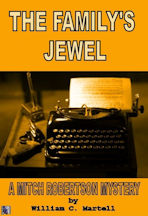
***
MITCH ROBERTSON #2: THE FAMILY'S JEWEL *** - For Kindle!
"The Presidential Suite of the Hollywood Hoover Hotel looked like a bloody battlefield: bodies everywhere, furniture broken, red liquid dripping from the walls, dead soldiers littering the elegant Berber rug as clouds of smoke overhead bounced between two air conditioning vents.
Mitch Robertson stepped over the body of an ex-child star turned sex tape star turned pop star and entered the room, spotted a gun on the floor and picked it up... careful not to spill his coffee with three pumps of mocha syrup from Penny’s Coffee Shop. That coffee was gold, the only thing keeping him going in this dazed state of wakefulness. The gun felt light. Holding it, he saw the silhouette of an 80s action star sitting sideways on a tipped over chair. Motionless. Was he dead? Mitch was still hung over from the Awards Party the night before, and wondered whether this was all some sort of crazy nightmare that he would wake up from... but when he tripped over the brown legs of a bottomless Superhero, flaccid junk encased in a condom but still wearing his mask, and hit the edge of the sofa, gun skittering and coffee spilling, he realized that it was all very real. What the hell had happened here?"
Short Novel. Only 99 cents - and no postage!
IT'S NEW!!
All About Rewrites!
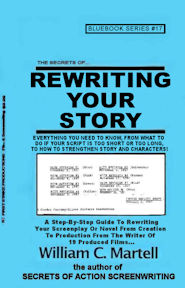
REWRITES Blue Book!
Rewriting In Waves?
When You Finish Your Screenplay Or Novel...
The Rewrites Begin!
The end is just the beginning! You’ve finished your story, but now the rewriting begins! This 405 page book shows you how to rewrite your screenplay or novel to perfection. Everything from Character Consistency to Shoeboxing to How To Give And Receive Notes to 15 Solutions If Your Script’s Too Long! and 15 Solutions If Your Script’s Too Short! to Finding The Cause Of A Story Problem to Good Notes Vs. Bad Notes to Finding Beta Readers to Avoiding Predictability to Learning To Be Objective About Your Work to Script Killer Notes and Notes From Idiots to Production Rewrites and What The Page Colors Mean? and a Complete Rewrite Checklist! The complete book on Rewriting Your Story!
Only: $4.99
HITCHCOCK FOR WRITERS!
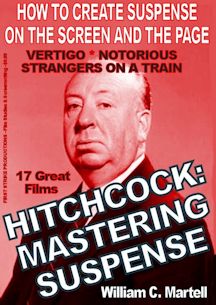
LEARN SUSPENSE FROM THE MASTER!
*** HITCHCOCK: MASTERING SUSPENSE *** - For Kindle!
Alfred Hitchcock, who directed 52 movies, was known as the *Master Of Suspense*; but what exactly is suspense and how can *we* master it? How does suspense work? How can *we* create “Hitchcockian” suspense scenes in our screenplays, novels, stories and films?
This book uses seventeen of Hitchcock’s films to show the difference between suspense and surprise, how to use “focus objects” to create suspense, the 20 iconic suspense scenes and situations, how plot twists work, using secrets for suspense, how to use Dread (the cousin of suspense) in horror stories, and dozens of other amazing storytelling lessons. From classics like “Strangers On A Train” and “The Birds” and “Vertigo” and “To Catch A Thief” to older films from the British period like “The 39 Steps” and “The Man Who Knew Too Much” to his hits from the silent era like “The Lodger” (about Jack The Ripper), we’ll look at all of the techniques to create suspense!
Only $5.99
NO KINDLE REQUIRED! Get the *free* app (any device, except your Mr. Coffee) on the order page on Amazon!
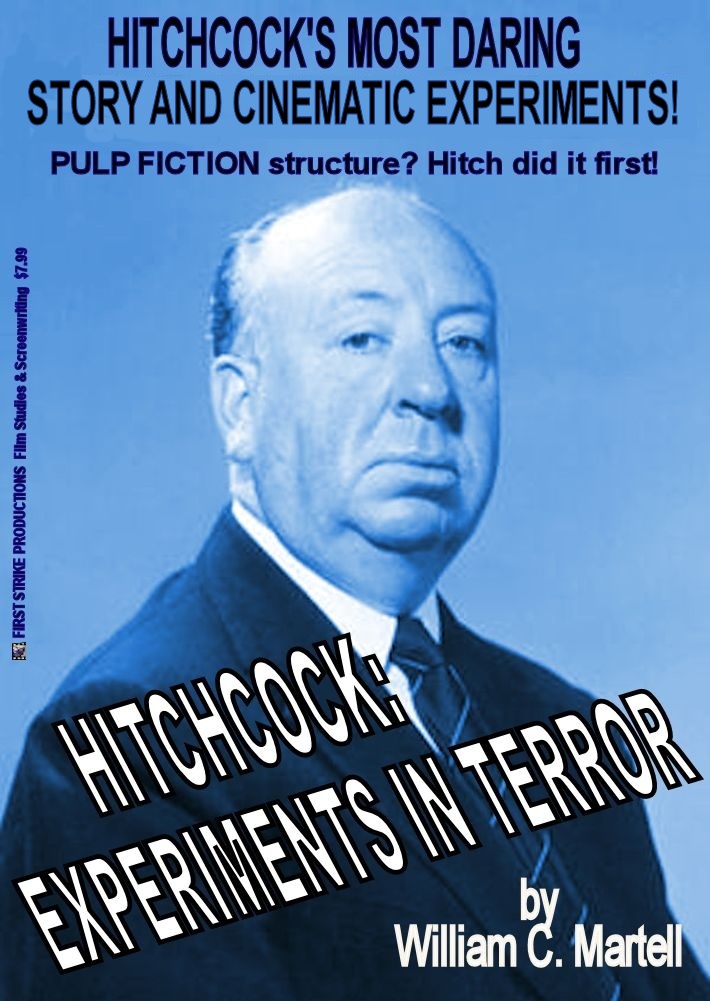
Strange Structures!
*** HITCHCOCK: EXPERIMENTS IN TERROR! *** - For Kindle!
***
Contained Thrillers like "Buried"? Serial Protagonists like "Place Beyond The Pines"? Multiple Connecting Stories like "Pulp Fiction"? Same Story Multiple Times like "Run, Lola, Run"?
HITCHCOCK DID IT FIRST!
This book focuses on 18 of Hitchcock's 52 films with wild cinema and story experiments which paved the way for modern films. Almost one hundred different experiments that you may think are recent cinema or story inventions... but some date back to Hitchcock's *silent* films! We'll examine these experiments and how they work. Great for film makers, screenwriters, film fans, producers and directors.
Only $5.99 - and no postage!

MAKES A GREAT GIFT!
*** THE SECRETS OF ACTION SCREENWRITING *** - For Kindle!
*** THE SECRETS OF ACTION SCREENWRITING *** - For Nook!
Why pay $510 for a used version of the 240 page 2000 version that used to retail for $21.95? (check it out!) when
you can get the NEW EXPANDED VERSION - over 500 pages - for just $9.99? New chapters, New examples, New techniques!
"SECRETS OF ACTION SCREENWRITING is the
best book on the practical nuts-and-bolts mechanics of writing a screenplay I've ever read."
- Ted Elliott, co-writer of MASK OF ZORRO, SHREK, PIRATES OF THE CARIBBEAN and the sequels (with Terry Rossio). (ie; 4 of the top 20 Box Office Hits Of ALL TIME.)
Only $9.99 - and no postage!
Tip FAQ

My New Script Secrets Newsletter!

STORY IN ACTION SERIES!

THE MISSION IMPOSSIBLE MOVIES
NEW: Updates On Films 7 & 8 Casting!
All Six Movies analyzed! All of the mission tapes, all of the “that’s impossible!” set pieces and stunts, the cons and capers - and how these scenes work, the twists and double crosses, the tension and suspense (and how to generate it), the concept of each film as a stand alone with a different director calling the shots (broken in the sixth film), the gadgets, the masks, the stories, the co-stars and team members (one team member has been in every film), the stunts Tom Cruise actually did (and the ones he didn’t), and so much more! Over 120,000 words of fun info!
THE MISSION IMPOSSIBLE MOVIES - 347 Pages - Only $3.99 !

BRAND NEW!
*** THE BOURNE MOVIES
NEW: Updates on TREADSTONE TV show!
All five "Bourne" movies (including "Legacy" and it's potential sequels) - what are the techniques used to keep the characters and scenes exciting and involving? Reinventing the thriller genre...
or following the "formula"? Five films - each with an interesting experiment! A detailed analysis of each
of the films, the way these thrillers work... as well as a complete list of box office and critical
statistics for each film. This book is great for writers, directors, and just fans of the series.
Only $3.99 - and no postage!
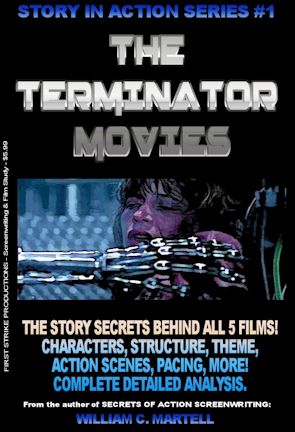
Over 240 pages!
*** THE TERMINATOR MOVIES *** - For Kindle!
He's back! The release of "Terminator: Dark Fate" is set to begin a new trilogy in
the Terminator story... 35 years after the first film was released. What draws us to these films about
a cybernetic organism from the future sent back in time? Why is there a new proposed trilogy every few
years? This book looks at all five Terminator movies from a story standpoint - what makes them work
(or not)? What are the techniques used to keep the characters and scenes exciting and involving? How
about those secret story details you may not have noticed? Containing a detailed analysis of each of
the five films so far, this book delves into the way these stories work... as well as a complete list of
box office and critical statistics for each film. This book is great for writers, directors, and just
fans of the series.
ONLY $3.99 - and no postage!
NO KINDLE REQUIRED! Get the *free* app (any device, except your Mr. Coffee) on the order page on Amazon!

NEW BUT OLD!
*** VINTAGE #1: HOW TO WRITE PHOTOPLAYS *** - For Kindle!
***
Screenwriting books have been around as long as films have. This series reprints vintage screenwriting books with a new introduction and history, plus new articles which look at how these lessons from almost 100 years ago apply to today’s screenplays. Anita Loos book is filled with information which still applies.
In addition to the full text of the original book, you get the full screenplay to Miss Loos' hit THE LOVE EXPERT, plus several new articles on the time period and women in Hollywood.
Only $2.99 - and no postage!
THE BLUE BOOKS!

FIND A GREAT IDEA!
*** YOUR IDEA MACHINE *** - For Kindle!
****
Expanded version with more ways to find great ideas! Your screenplay is going to begin with an idea. There are good ideas and bad ideas and commercial ideas and personal ideas. But where do you find ideas in the first place? This handbook explores different methods for finding or generating ideas, and combining those ideas into concepts that sell. The Idea Bank, Fifteen Places To Find Ideas, Good Ideas And Bad Ideas, Ideas From Locations And Elements, Keeping Track Of Your Ideas, Idea Theft - What Can You Do? Weird Ways To Connect Ideas, Combing Ideas To Create Concepts, High Concepts - What Are They? Creating The Killer Concept, Substitution - Lion Tamers & Hitmen, Creating Blockbuster Concepts, Magnification And The Matrix, Conflict Within Concept, Concepts With Visual Conflict, Avoiding Episodic Concepts, much more! Print version is 48 pages, Kindle version is over 175 pages!
Only $4.99 - and no postage!
FIGURE OUT YOUR STORY!
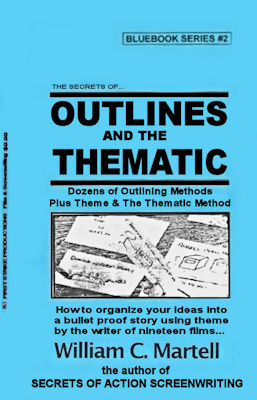
OUTLINES & THE THEMATIC Blue Book.
ARE YOUR SCENES IN THE RIGHT ORDER?
AND ARE THEY THE RIGHT SCENES?
Your story is like a road trip... but where are you going? What's the best route to get there? What are the best sights to see along the way? Just as you plan a vacation instead of just jump in the car and start driving, it's a good idea to plan your story. An artist does sketches before breaking out the oils, so why shouldn't a writer do the same? This Blue Book looks at various outlining methods used by professional screenwriters like Wesley Strick, Paul Schrader, John August, and others... as well as a guest chapter on novel outlines. Plus a whole section on the Thematic Method of generating scenes and characters and other elements that will be part of your outline. The three stages of writing are: Pre-writing, Writing, and Rewriting... this book looks at that first stage and how to use it to improve your screenplays and novels.
Only $4.99 - and no postage!
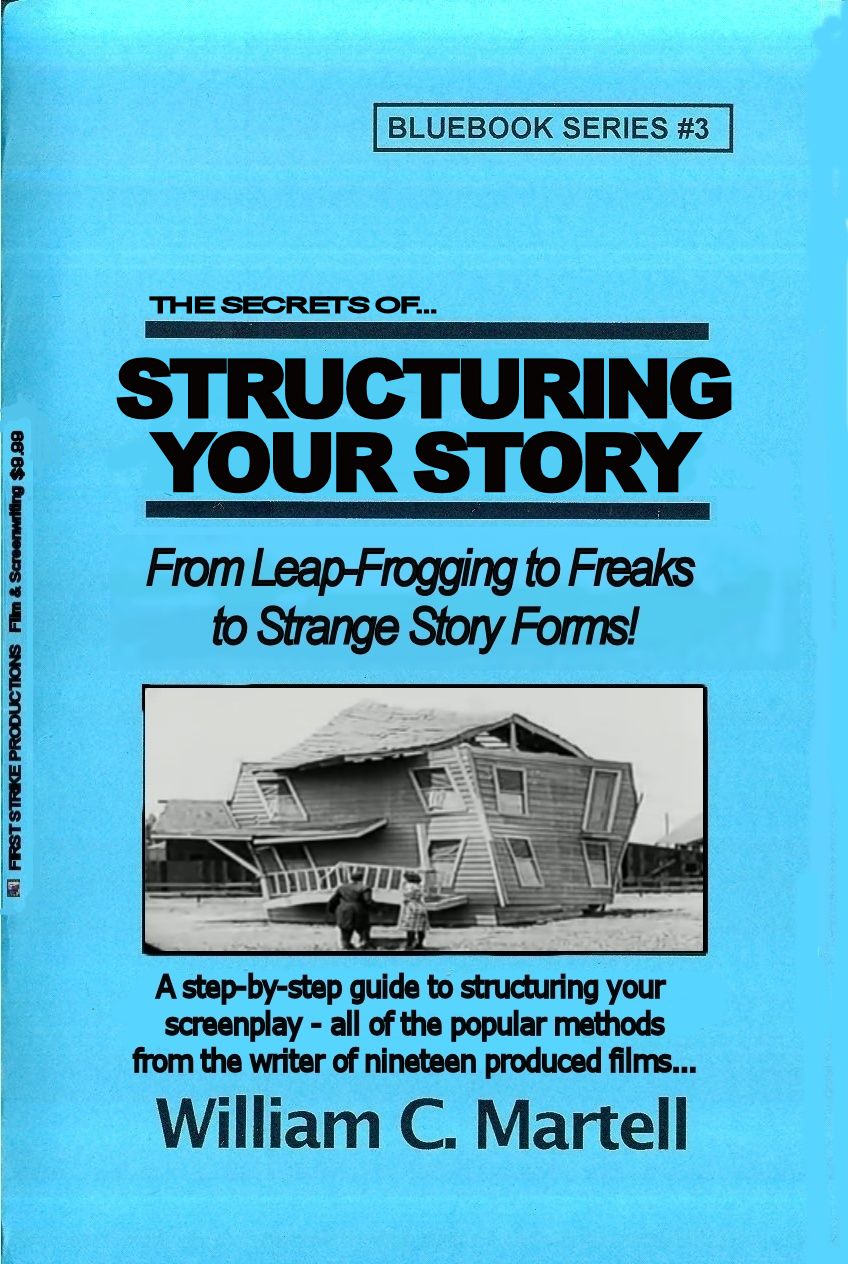
GOT STRUCTURE?!
*** STRUCTURING YOUR STORY *** - For Kindle!
William Goldman says the most important single element of any screenplay is structure. It’s the skeleton under the flesh and blood of your story. Without it, you have a spineless, formless, mess... a slug! How do you make sure your structure is strong enough to support your story? How do you prevent your story from becoming a slug? This Blue Book explores different types of popular structures from the basic three act structure to more obscure methods like leap-frogging. We also look at structure as a verb as well as a noun, and techniques for structuring your story for maximum emotional impact. Most of the other books just look at *structure* and ignore the art of *structuring* your story. Techniques to make your story a page turner... instead of a slug!
Only $4.99 - and no postage!
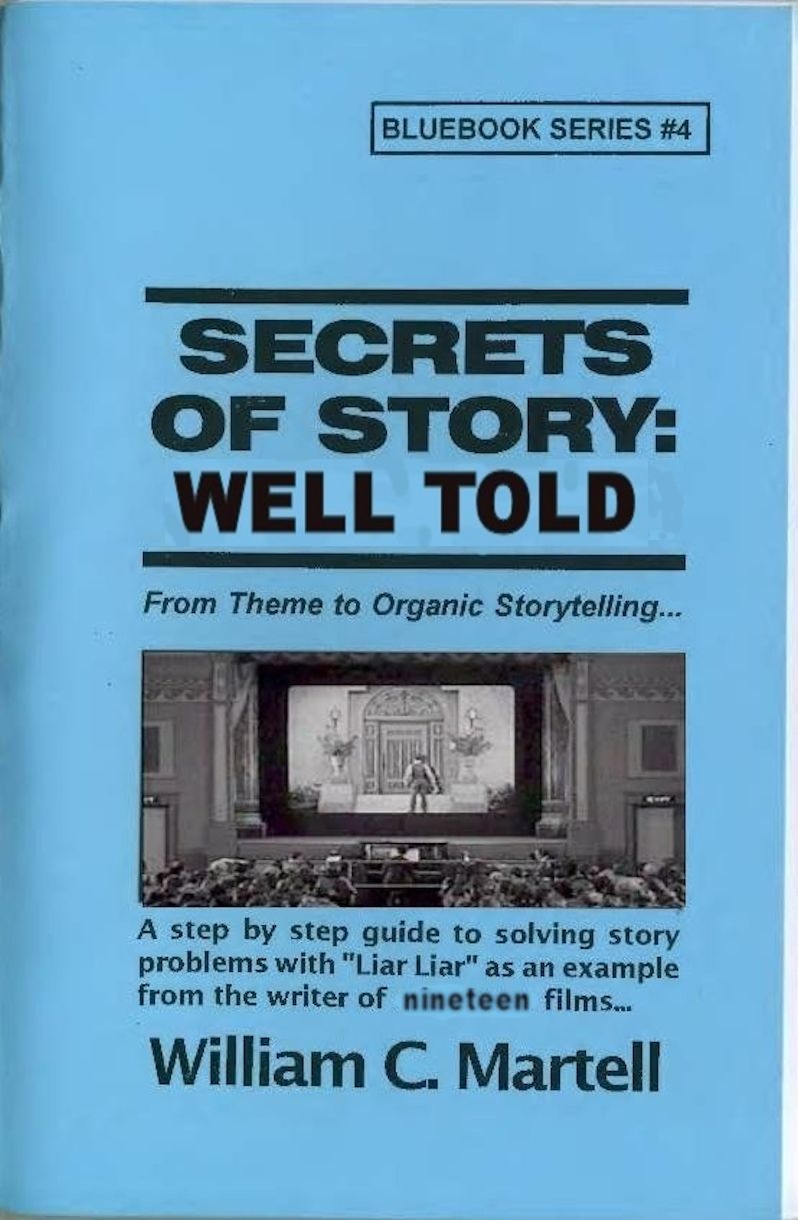
STORY: WELL TOLD!
*** STORY: WELL TOLD *** - For Kindle!
This book takes you step-by-step through the construction of a story... and how to tell a story well, why Story always starts with character... but ISN'T character, Breaking Your Story, Irony, Planting Information, Evolving Story, Leaving No Dramatic Stone Unturned, The Three Greek Unities, The Importance Of Stakes, The Thematic Method, and how to create personal stories with blockbuster potential. Ready to tell a story?
Print version was 48 pages, Kindle version is over 85,000 words - 251 pages!
Only $4.99 - and no postage!

START STRONG!
*** HOOK 'EM IN TEN *** - For Kindle!
Your story doesn't get a second chance to make a great first impression, and this book shows you a
bunch of techniques on how to do that. From the 12 Basic Ways To Begin Your Story, to the 3 Stars Of
Your First Scene (at least one must be present) to World Building, Title Crawls, Backstory, Starting
Late, Teasers and Pre Title Sequences, Establishing Theme & Motifs (using GODFATHER PART 2), Five Critical
Elements, Setting Up The Rest Of The Story (with GODFATHER), and much more! With hundreds of examples
ranging from Oscar winners to classic films like CASABLANCA to some of my produced films (because
I know exactly why I wrote the scripts that way). Biggest Blue Book yet!
Print version was 48 pages, Kindle version is over 100,000 words - 312 pages!
Only $4.99 - and no postage!
NO KINDLE REQUIRED! Get the *free* app (any device, except your Mr. Coffee) on the order page on Amazon!
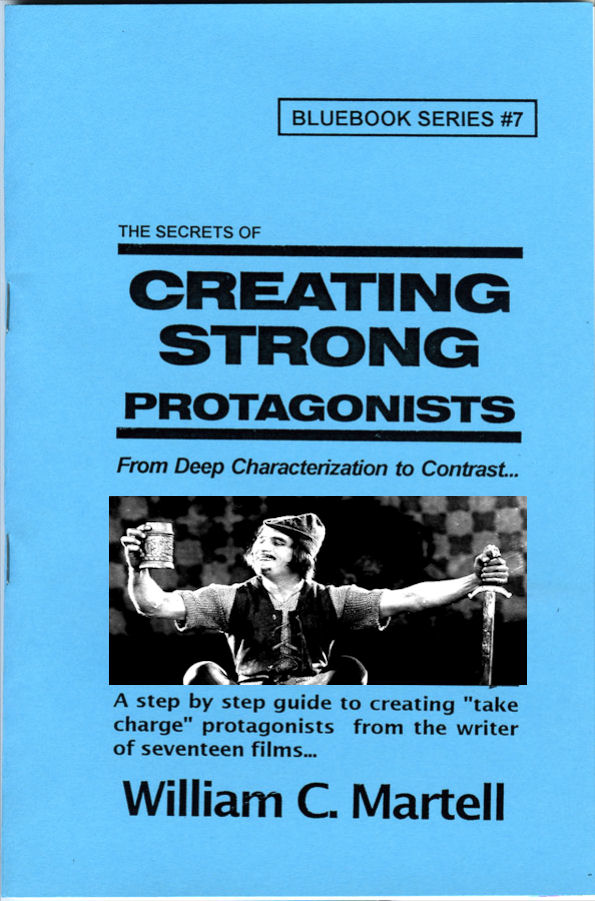
MOVIES ARE CHARACTERS!
*** CREATING STRONG PROTAGONISTS *** - For Kindle!
*** CREATING STRONG PROTAGONISTS *** - For Nook!
Expanded version with more ways to create interesting protagonists! A step-by-step guide to creating "take charge" protagonists. Screenplays are about characters in conflict... characters in emotional turmoil... Strong three dimensional protagonists who can find solutions to their problems in 110 pages. But how do you create characters like this? How do you turn words into flesh and blood? Character issues, Knowing Who Is The Boss, Tapping into YOUR fears, The Naked Character, Pulp Friction, Man With A Plan, Character Arcs, Avoiding Cliche People, Deep Characterization, Problem Protagonists, 12 Ways To Create Likable Protagonists (even if they are criminals), Active vs. Reactive, The Third Dimension In Character, Relationships, Ensemble Scripts, and much, much more. Print version is 48 pages, Kindle version is once again around 205 pages!
ONLY $4.99 - and no postage!
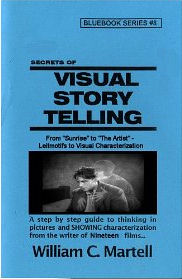
I WRITE PICTURES!
*** VISUAL STORYTELLING *** - For Kindle! (exclusive)
Show Don't Tell - but *how* do you do that? Here are techniques to tell stories visually! Using Oscar Winning Films and Oscar Nominated Films as our primary examples: from the first Best Picture Winner "Sunrise" (1927) to the Oscar Nominated "The Artist" (which takes place in 1927) with stops along the way Pixar's "Up" and Best Original Screenplay Winner "Breaking Away" (a small indie style drama - told visually) as well as "Witness" and other Oscar Winners as examples... plus RISE OF THE PLANET OF THE APES. Print version is 48 pages, Kindle version is over 200 pages!
ONLY $4.99 - and no postage!
DESCRIPTION & VOICE Blue Book!

DESCRIPTION & VOICE Blue Book.
IS HALF OF YOUR STORY IN TROUBLE?
Most screenplays are about a 50/50 split between dialogue and description - which means your description is just as important as your dialogue. It just gets less press because the audience never sees it, the same reason why screenwriters get less press than movie stars. But your story will never get to the audience until readers and development executives read your script... so it is a very important factor. Until the movie is made the screenplay is the movie and must be just as exciting as the movie. So how do you make your screenplay exciting to read? Description is important in a novel as well, and the “audience” does read it... how do we write riveting description?
Only $4.99 and no postage!

PRO DIALOGUE TECHNIQUES!
*** DIALOGUE SECRETS *** - For Kindle!
***
Expanded version with more ways to create interesting dialogue! How to remove bad dialogue (and what *is* bad dialogue), First Hand Dialogue, Awful Exposition, Realism, 50 Professional Dialogue Techniques you can use *today*, Subtext, Subtitles, Humor, Sizzling Banter, *Anti-Dialogue*, Speeches, and more. Tools you can use to make your dialogue sizzle! Special sections that use dialogue examples from movies as diverse as "Bringing Up Baby", "Psycho", "Double Indemnity", "Notorious", the Oscar nominated "You Can Count On Me", "His Girl Friday", and many more! Print version is 48 pages, Kindle version is over 175 pages!
Only $4.99 - and no postage!

WHAT IS A SCENE?
*** SCENE SECRETS *** - For Kindle!
***
What is a scene and how many you will need? The difference between scenes and sluglines. Put your scenes on trial for their lives! Using "Jaws" we'll look at beats within a scene. Scene DNA. Creating set pieces and high concept scenes. A famous director talks about creating memorable scenes. 12 ways to create new scenes. Creating unexpected scenes. Use dramatic tension to supercharge your scenes. Plants and payoffs in scenes. Plus transitions and buttons and the all important "flow"... and more! Over 65,000 words! Print version was 48 pages, Kindle version is around 210 pages!
Only $4.99 - and no postage!

SUBPLOTS?
*** SUPPORTING CHARACTER SECRETS *** - For Kindle! (Exclusive)
Expanded version with more techniques to flesh out your Supporting Characters and make them individuals. Using the hit movie BRIDESMAIDS as well as other comedies like THE HANGOVER and TED and HIGH FIDELITY and
40 YEAR OLD VIRGIN and many other examples we look at ways to make your Supporting Characters come alive on the page.
Print version was 48 pages, Kindle version is around 170 pages!
ONLY $4.99 - and no postage!

ACT TWO SOLUTIONS!
*** ACT TWO SECRETS *** - For Kindle!
Expanded version with more techniques to help you through the desert of Act Two! Subjects Include: What Is Act Two? Inside Moves, The 2 Ps: Purpose & Pacing, The 4Ds: Dilemma, Denial, Drama and Decision, Momentum, the Two Act Twos, Subplot Prisms, Deadlines, Drive, Levels Of Conflict, Escalation, When Act Two Begins and When Act Two Ends, Scene Order, Bite Sized Pieces, Common Act Two Issues, Plot Devices For Act Two, and dozens of others. Over 67,000 words (that’s well over 200 pages) of tools and techniques to get you through the desert of Act Two alive!
Print version was 48 pages, Kindle version is well over 200 pages!
ONLY $4.99 - and no postage!
All About Endings!

GRAND FINALES Blue Book!
The Perfect Ending For Your Story!
The First Ten Pages Of Your Screenplay Are Critical,
But What About The Last 10 Pages?
Creating the perfect ending to your story! This 100,000 word book shows you how to end your story with a bang, rather than a whimper. Everything from Resolution Order to Act Three Tools to Happy or Sad Endings? to How The Beginning Of Your Story Has Clues To The Ending (in case you were having trouble figuring out how the story should end) to Falling Action to How To Avoid Bad Endings to Writing The Perfect Twist Ending to Setting Up Sequels & Series to Emotional Resolutions to How To Write Post Credit Sequences to Avoiding Deus Ex Machinas, to 20 Different Types Of Ends (and how to write them) and much more! Everything about endings for your screenplay or novel!
Only: $4.99
NO KINDLE REQUIRED! Get the *free* app (any device, except your Mr. Coffee) on the order page on Amazon!
All About LOGLINES, TREATMENTS, and PITCHING!

LOGLINES, TREATMENTS, and PITCHING! Blue Book!
Distilling Your Screenplay!
Loglines, Treatments, Pitching, Look Books, Pitch Decks, One Pagers, Rip-O-Matics?
You have written a brilliant 110 page screenplay, but how do you get anyone to read it? You need to distill it down into some form of verbal moonshine or story rocket fuel that will ignite that bored development executive or manager or agent and get them to request your screenplay. But how do you shrink those 110 pages into a 25 word logline or a 2 minute elevator pitch or a one page synopsis or a short paragraph? This 100,000 word book shows you how! Everything you need to know! From common logline mistakes (and how to solve them) to how your pitch can reveal story problems to the 4 types of pitches!
272 Pages - ONLY $4.99!
READY TO BREAK IN?
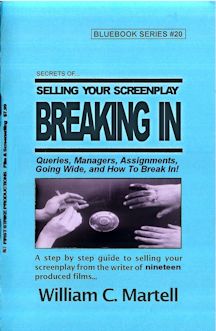
THE BUISINESS SIDE
*** BREAKING IN BLUE BOOK *** - For Kindle!
Should really be called the BUSINESS BLUE BOOK because it covers almost everything you will need to
know for your screenwriting career: from thinking like a producer and learning to speak their language,
to query letters and finding a manager or agent, to making connections (at home and in Hollywood) and
networking, to the different kinds of meetings you are will have at Studios, to the difference between
a producer and a studio, to landing an assignment at that meeting and what is required of you when you
are working under contract, to contracts and options and lawyers and... when to run from a deal!
Information you can use *now* to move your career forward! It's all here in the Biggest Blue Book yet!
Print version was 48 pages, Kindle version is over 400 pages!
$4.99 - and no postage!

Use your creative energy to focus on the content; let Final Draft take care of the style. Final Draft is the number-one selling application specifically designed for writing movie scripts, television episodics and stage plays. Its ease-of-use and time-saving features have attracted writers for almost two decades positioning Final Draft as the Professional Screenwriters Choice. Final Draft power users include Academy, Emmy and BAFTA award winning writers like Oliver Stone, Tom Hanks, Alan Ball, J.J. Abrams, James Cameron and more.
* * * Buy It!
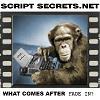
|
|
|
|
|
SECRETS OF ACTION SCREENWRITING
|
|
 IT'S BACK! SECRETS OF ACTION SCREENWRITING
IT'S BACK! SECRETS OF ACTION SCREENWRITING
Over 460 pages packed with tips and techniques.
How to
write a plot twist,
the four kinds of suspense (and how to create it), reversals, ten ways to invent new action scenes, secrets and lies,
creating the ultimate
villain, five kinds of love interests, MORE! CLICK HERE!
|
|
CLASSES ON MP3
|
|
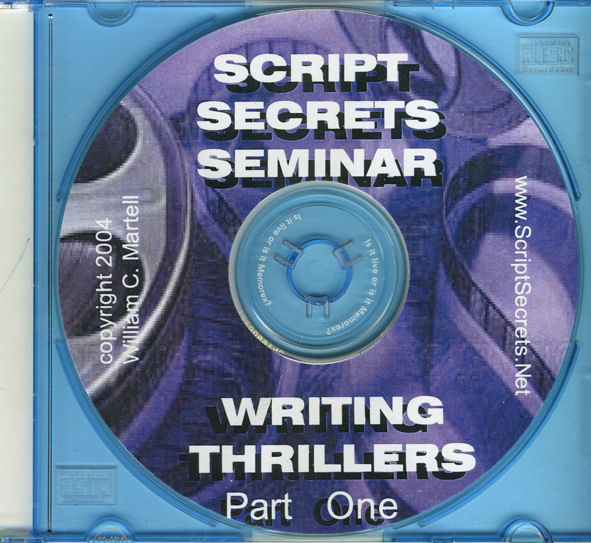 CLASSES ON MP3! Take a class on MP3! GUERRILLA MARKETING - NO AGENT? NO PROBLEM! and WRITING THRILLERS (2 MP3s). Full length classes on MP3. Now Available: IDEAS & CREATIVITY, WRITING HORROR, WRITING INDIE FILMS, more!
CLASSES ON MP3! Take a class on MP3! GUERRILLA MARKETING - NO AGENT? NO PROBLEM! and WRITING THRILLERS (2 MP3s). Full length classes on MP3. Now Available: IDEAS & CREATIVITY, WRITING HORROR, WRITING INDIE FILMS, more!
Take classes on MP3!
|
|
MY OTHER SITES
|
|
B MOVIE WORLD
Cult Films, Exploitation, Bikers & Women In Prison, Monster Movies.
FIRST STRIKE PRODUCTIONS
Producing my own scripts, investment possibilities, pipe dreams.
|
|
NAKED SCREENWRITING MP3s
|
|
 The NAKED SCREENWRITING CLASS ON MP3!
The 2001 London Class on 8 MP3s! Recorded *live* the morning after the Raindance Film Festival
wrapped. The two day class on 8CD worth, plus a workbook, plus a bonus CD.
The NAKED SCREENWRITING CLASS ON MP3!
The 2001 London Class on 8 MP3s! Recorded *live* the morning after the Raindance Film Festival
wrapped. The two day class on 8CD worth, plus a workbook, plus a bonus CD.
The 2 Day Class on MP3!
|
|
ONLINE CLASSES
|
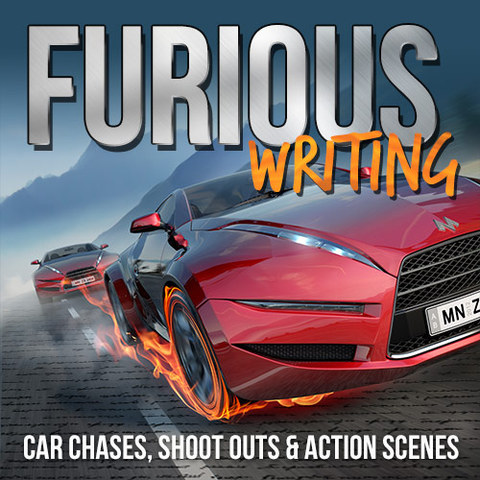
|
|
BILL'S CORNER
|
|
My
nineteen produced films, interviews with me in magazines,
several sample scripts, my available scripts list... And MORE!
...............................BILL'S CORNER
Available Scripts
|
|
E BOOKS PAGE
|
|
 E BOOKS: New Blue Books and Novelettes!
E BOOKS: New Blue Books and Novelettes!
I am expanding all of the Blue Books from around 44 pages of
text to around 200 pages! Some are over 250 pages! See what is availabale and what is coming soon!Also, I've been writing Novelletes and there
will soon be novels.
E BOOKS: BLUE BOOKS & NOVELLETES
|
|
BOOKLETS & PRODUCTS
|
|
 FIRST STRIKE BLUE BOOKS
FIRST STRIKE BLUE BOOKS
Each Blue Book is 48
pages and focuses on a different aspect of screenwriting. Dialogue. Visual Storytelling. Your First Ten Pages. Act 2 Booster. Protagonists. Great Endings.
Seventeen Blue Books now available!
THE SECRETS OF ACTION SCREENWRITING OUT OF PRINT!
|
|
|
|
|

